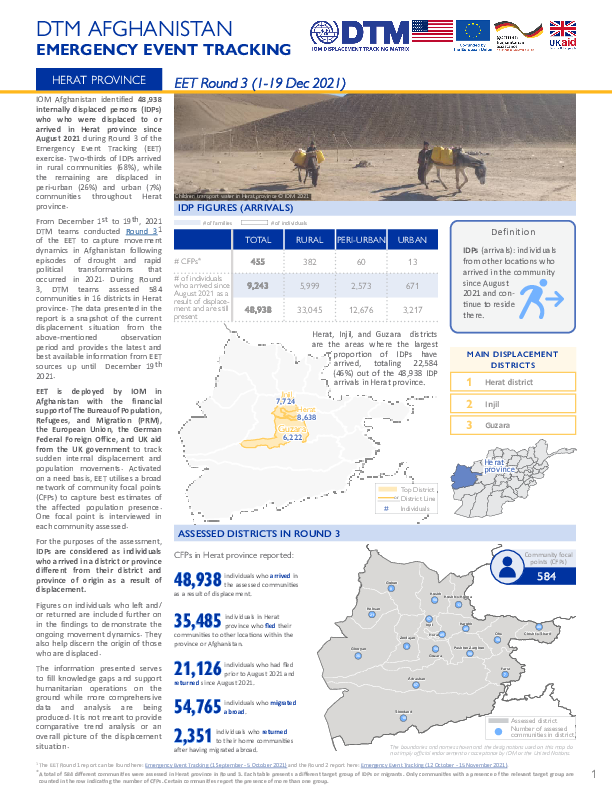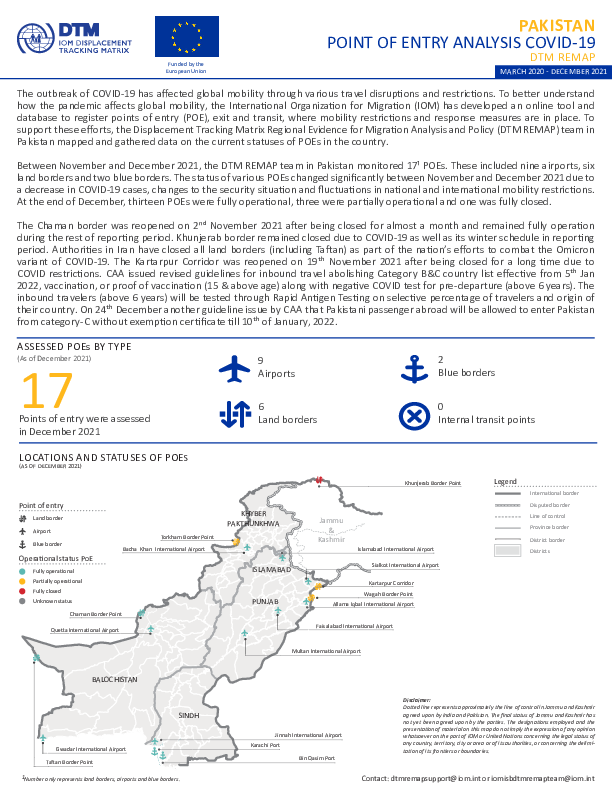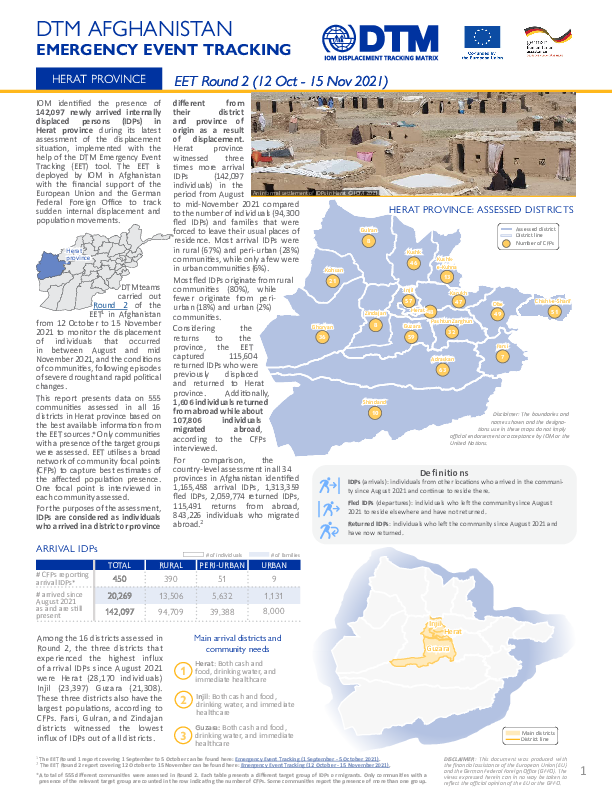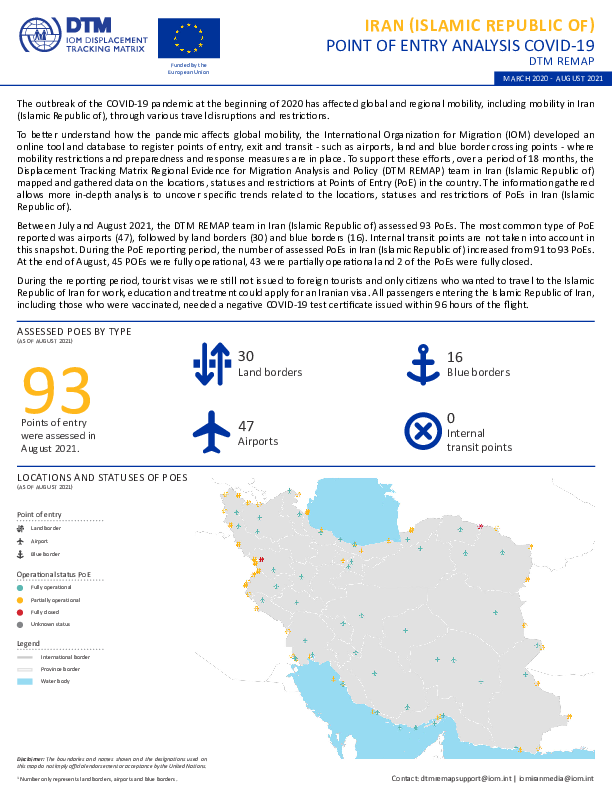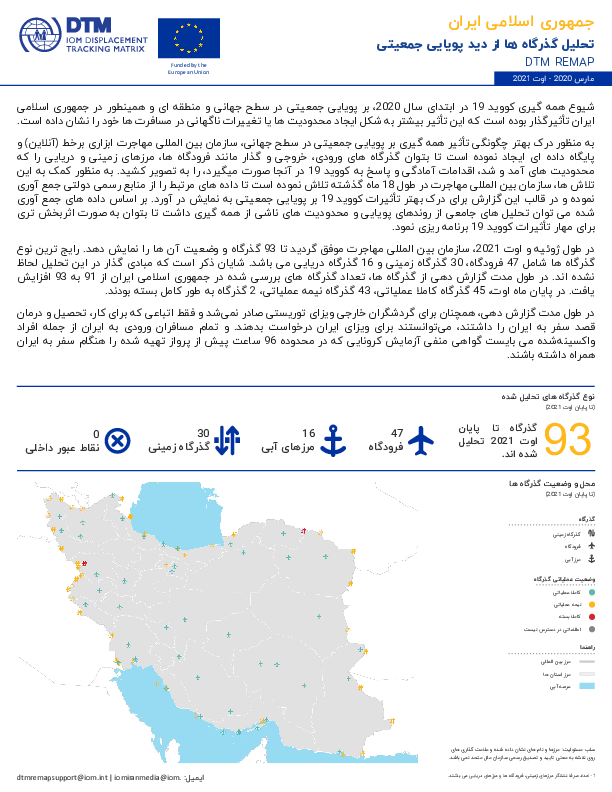-
Countries
-
Data and Analysis
-
Special Focus
-
Crisis Responses
Asia and the Pacific
DTM Asia and the Pacific
DTM Operations in the region
- Active DTM operation
- Past DTM operation
Para obtener resultados de búsqueda más avanzados, vaya a la Página de búsqueda avanzada de informes
Pakistan - Flow Monitoring of Undocumented Afghan Returnees from Pakistan (October - December 2021)
IOM Pakistan collects data on the outflows of undocumented Afghan migrants at the Torkham and Chaman border crossing points in an effort to better understand the migration movements of undocumented Afghan migrants returning to Afghanistan from Pakistan.
Pakistan - Flow Monitoring of Undocumented Afghan Returnees from Pakistan (1 — 14 January 2022)
IOM Pakistan collects data on the outflows of undocumented Afghan migrants at the Torkham and Chaman border crossing points in an effort to better understand the migration movements of undocumented Afghan migrants returning to Afghanistan from Pakistan.
Afghanistan — Emergency Event Tracking Kabul Province (1 December - 19 December 2021)
IOM Afghanistan identified 93,631 internally displaced persons (IDPs) who were displaced to or arrived in Kabul province since August 2021 during Round 3 of the Emergency
Afghanistan — Emergency Event Tracking Herat Province (01 December - 19 December 2021)
IOM Afghanistan identified 48,938 internally displaced persons (IDPs) who were displaced to or arrived in Herat province since August 2021 during Round 3 of the Emergency
Islamic Republic Of Iran - Point Of Entry (PoE) COVID-19 Dashboard (March 2020 to October 2021)
The outbreak of the COVID-19 pandemic at the beginning of 2020 has affected global and regional mobility, including mobility in Iran (Islamic Republic of), through various travel disruptions and restrictions.
ج.ا. ایران - تحلیل گذرگاهها از دید پویایی جمعیتی و کووید19 - مارس 2020 - اکتبر 2021
March 2020 - October 2021
Bangladesh — People Living with Disabilities in Cox’s Bazar: Understanding Perceptions on Aid Equity and Access: Preliminary findings (January 2022)
In Cox’s Bazar, identifying and meeting the unique needs of people living with disabilities has been a challenge throughout the humanitarian response, while quantitative assessments and perception tracking have struggled to understand their diverse experiences and perspectives.
Bangladesh – COVID-19 PoE Analysis Dashboard (March 2020 - December 2021)
The outbreak of the COVID-19 pandemic at the beginning of 2020 has affected global and regional mobility, including mobility in Bangladesh, through various travel disruptions and restrictions.
Pakistan – COVID-19 Point of Entry (PoE) Analysis (March 2020 – December 2021)
The outbreak of COVID-19 has affected global mobility through various travel disruptions and restrictions.
Afghanistan — Emergency Event Tracking Round 3 (1 - 19 December 2021)
IOM Afghanistan identified 988,817 internally displaced persons (IDPs) who arrived in the assessed communities since
Pakistan - Flow Monitoring of Undocumented Afghan Returnees from Pakistan (19 - 31 December 2021)
IOM Pakistan collects data on the outflows of undocumented Afghan migrants at the Torkham and Chaman border crossing points in an effort to better understand the migration movements of undocumented Afghan migrants returning to Afghanistan from Pakistan.
Afghanistan — Emergency Event Tracking Kabul Province (12 October - 15 November 2021)
IOM identified the presence of 69,153 newly arrived Internally Displaced Persons (IDPs) in Kabul province during its latest assessment of the displacement situation, implemented with the help of the DTM Emergency Event Tracking (EET) tool.
Afghanistan — Emergency Event Tracking Herat Province (12 October - 15 November 2021)
IOM identified the presence of 142,097 newly arrived internally displaced persons (IDPs) in Herat province during its latest assessment of the displacement situation, implemented with the help of the DTM Emergency Event Tracking (EET) tool.
Islamic Republic of Iran - Iranian Nationals in Europe 2020 - A Multiple Source Snapshot
This snapshot summarizes available data on Iranian nationals in Europe in 2020. The first page visualizes the number of Iranian nationals who arrived by land and sea in the European Union and those who transited through the Western Balkan and Eastern Europe region in 2020.
جمهوری اسلامی ایران - اتباع ایرانی در اروپا 2020 - بر اساس منابع متعدد
این تصویر اجمالی، خلاصه ای از داده های موجود در مورد اتباع ایرانی در اروپا در سال 2020 می باشد. صفحه اول، نمایانگر تعداد اتباع ایرانی وارد شده از طریق مرز های زمینی و دریایی به اتحادیه اروپا و کسانی که از طریق بالکان غربی و اروپای شرقی در سال 2020 وارد اروپا شده اند، می باشد.
Pakistan — Pakistani Nationals in Europe 2020 - A Multiple Source Snapshot
This snapshot summarizes available data on Pakistani nationals in Europe in 2020. The first page visualizes the number of Pakistani nationals who arrived by land and sea in the European Union and those who transited through the Western Balkan and Eastern Europe region in 2020.
Afghanistan — Emergency Event Tracking (12 October - 15 November 2021)
The DTM Emergency Event Tracking (EET) tool is deployed with funding from the European Union and the German Federal Foreign Office to track sudden internal displacement and population movements.
Papua New Guinea — Situation Update — Manam Volcanic Activity (11 November 2021)
Manam volcano in Papua New Guinea's Madang Province started emitting ash on 20 October 2021. The emitted volcanic ash caused a thick dark smoke that covered the entire Manam Island.
Bangladesh – Bangladeshi Migrants Presence in Libya – March-April 2020
According to available data from the Displacement Tracking Matrix (DTM) in Libya compiled in the following snapshot by the DTM REMAP project, funded by the European Union (EU), 19,710 Bangladeshi nationals were identified through DTM’s baseline Mobility Tracking module in Libya between March and
Bangladesh – Bangladeshi Migrants Presence in Libya – March-April 2021
According to available data from the Displacement Tracking Matrix (DTM) in Libya compiled in the following snapshot by the DTM REMAP project, funded by the European Union (EU), 20,123 Bangladeshi nationals were identified through DTM’s baseline Mobility Tracking module in Libya between March and
Islamic Republic Of Iran - Point Of Entry (PoE) COVID-19 Dashboard (March 2020 to August 2021)
The outbreak of the COVID-19 pandemic at the beginning of 2020 has affected global and regional mobility, including mobility in Iran (Islamic Republic of), through various travel disruptions and restrictions.
ج.ا. ایران - تحلیل گذرگاهها از دید پویایی جمعیتی و کووید19 - مارس 2020 الی اوت 2021
March 2020 - August 2021
Pakistan - Flow Monitoring of Undocumented Afghan Returnees from Pakistan (24 October - 06 November 2021)
IOM Pakistan collects data on the outflows of undocumented Afghan migrants at the Torkham and Chaman border crossing points in an effort to better understand the migration movements of undocumented Afghan migrants returning to Afghanistan from Pakistan.
REMAP Point of Entry (PoE) – COVID-19 - Dashboard (March 2020 - August 2021)
The outbreak of the COVID-19 pandemic at the beginning of 2020 has affected global and regional mobility, including mobility in the DTM REMAP project countries, through various travel disruptions and restrictions.
Pagination
Para obtener resultados de búsqueda más avanzados, vaya a la Página de búsqueda avanzada de conjuntos de datos
Pagination
- First page
- Previous page
- 1
- 2
- 3
- 4
- 5
- 6
Pagination
- First page
- Previous page
- 1
- 2
- 3
- 4
- 5
- 6
- 7



